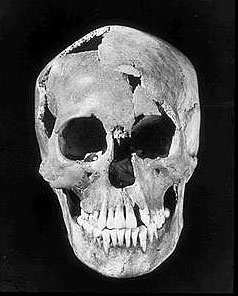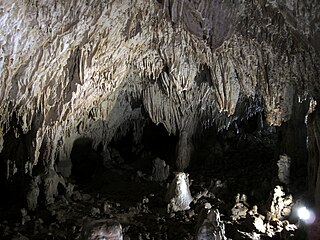Related Research Articles

Vindolanda was a Roman auxiliary fort (castrum) just south of Hadrian's Wall in northern England, which it originally pre-dated. Archaeological excavations of the site show it was under Roman occupation from roughly 85 AD to 370 AD. Located near the modern village of Bardon Mill in Northumberland, it guarded the Stanegate, the Roman road from the River Tyne to the Solway Firth. It is noted for the Vindolanda tablets, a set of wooden leaf-tablets that were, at the time of their discovery, the oldest surviving handwritten documents in Britain.

The Red Lady of Paviland is an Upper Paleolithic partial skeleton of a male dyed in red ochre and buried in Wales 33,000 BP. The bones were discovered in 1823 by William Buckland in an archaeological dig at Goat's Hole Cave – one of the limestone caves between Port Eynon and Rhossili on the Gower Peninsula, Swansea, south Wales.

The Neandertal is a small valley of the river Düssel in the German state of North Rhine-Westphalia, located about 12 km (7.5 mi) east of Düsseldorf, the capital city of North Rhine-Westphalia. The valley lies within the limits of the towns of Erkrath and Mettmann. In August 1856, the area became famous for the discovery of Neanderthal 1, one of the first specimens of Homo neanderthalensis to be found.

Għar Dalam is a 144 metre long phreatic tube and cave, or cul-de-sac, located in the outskirts of Birżebbuġa, Malta. The cave contains the bone remains of animals that were stranded and subsequently became extinct in Malta at the end of the Last Glacial Maximum. It has lent its name to the Għar Dalam phase in Maltese prehistory, and is viewed as one of Malta's most important national monuments. Pottery similar to that found in Stentinello was found at Għar Dalam, but lacking details such as stamp decorations.

Liang Bua is a limestone cave on the island of Flores, Indonesia, slightly north of the town of Ruteng in Manggarai Regency, East Nusa Tenggara. The cave demonstrated archaeological and paleontological potential in the 1950s and 1960s as described by the Dutch missionary and archaeologist Theodor L. Verhoeven.

Catanauan, officially the Municipality of Catanauan, is a 1st class municipality in the province of Quezon, Philippines. According to the 2020 census, it has a population of 72,752 people.

Kalibangān is a town located at 29.47°N 74.13°E on the left or southern banks of the Ghaggar in Tehsil Pilibangān, between Suratgarh and Hanumangarh in Hanumangarh District, Rajasthan, India 205 km. from Bikaner. It is also identified as being established in the triangle of land at the confluence of Drishadvati and Sarasvati Rivers. The prehistoric and pre-Mauryan character of Indus Valley civilization was first identified by Luigi Tessitori at this site. Kalibangan's excavation report was published in its entirety in 2003 by the Archaeological Survey of India, 34 years after the completion of excavations. The report concluded that Kalibangan was a major provincial capital of the Indus Valley Civilization. Kalibangan is distinguished by its unique fire altars and "world's earliest attested ploughed field". It is around 2900 BC that the region of Kalibangan developed into what can be considered a planned city.

Palwal is a city and a municipal council. It is the headquarters of Palwal district, the 21st district of Haryana state in northern India. It is a centre of for the cotton trade in the area. It is also a part of National Capital Region.

The straight-tusked elephant is an extinct species of elephant that inhabited Europe and Western Asia during the Middle and Late Pleistocene. Recovered individuals have reached up to 4–4.2 metres (13.1–13.8 ft) in height, and an estimated 11.3–15 tonnes in weight. The straight-tusked elephant probably lived in small herds, flourishing in interglacial periods, when its range would extend as far north as Great Britain. Isolated tusks are often found while partial or whole skeletons are rare, and there is evidence of predation by early humans. It is the ancestral species of most dwarf elephants that inhabited islands in the Mediterranean.

Minnesota Woman, also known as Pelican Rapids-Minnesota Woman, is the skeletal remains of a woman thought to be 8,000 years old. The bones were found near Pelican Rapids, Minnesota on June 16, 1931, during construction on U.S. Route 59. The bones were brought to Albert Jenks at the University of Minnesota, who identified them as the bones of a woman who was 15 or 16 years old, but who had never borne children. The woman had two artifacts—a dagger made from an elk's horn and a conch shell pendant. The conch shell came from a whelk species known as Sinistrofulgur perversum, which had previously only been known to exist in Florida.

The Syrian elephant or Western Asiatic elephant was the westernmost population of the Asian elephant, which became extinct in ancient times. Skeletal remains of E. m. asurus have been recorded from the Middle East: Iran, Iraq, Syria, and Turkey from periods dating between at least 1800 BC and likely 700 BC. Due to the lack of any Late Pleistocene or early to mid Holocene record for Asian elephants in the region, there are suggestions that the elephants were anthropogenically introduced into the region during the Bronze Age, though this is disputed.

Fort Rock Cave was the site of the earliest evidence of human habitation in the US state of Oregon before the excavation of Paisley Caves. Fort Rock Cave featured numerous well-preserved sagebrush sandals, ranging from 9,000 to 13,000 years old. The cave is located approximately 1.5 miles (2.4 km) west of Fort Rock near Fort Rock State Natural Area in Lake County. Fort Rock Cave was declared a National Historic Landmark in 1961, and added to the National Register of Historic Places in 1966.

The region of Semna is 15 miles south of Wadi Halfa and is situated where rocks cross the Nile narrowing its flow—the Semna Cataract.

Brunswick Town was a prominent town in colonial North Carolina. It was the first successful European settlement in the Cape Fear region, a major British port in the 18th century, and home to two provincial governors. Brunswick Town lasted 50 years (1726–1776) until it was raided by the British Army during the American Revolutionary War and never rebuilt. During the American Civil War, 86 years after the town was abandoned, a large portion of the town was covered by earthworks for the construction of Fort Anderson.

St Nicholas Shambles was a medieval church in the City of London, which stood on the corner of Butcher Hall Lane and Newgate Street. It took its name from the Shambles, the butchers area in the west of Newgate Street. The church is first mentioned as St. Nicholas de Westrnacekaria. In 1253 Walter de Cantilupe, Bishop of Worcester granted indulgences to its parishioners.

On Your Knees Cave (49-PET-408) is an archaeological site located in southeastern Alaska. Human remains were found at the site in 1996 that dated between 9,730 ±60 and 9,880±50 radiocarbon YBP or a calendrical date of 10,300 YBP. In addition to human skeletal remains, stone tools and animal bones were discovered. DNA analyses performed on the human skeletal remains document the presence of mitochondrial haplogroup D which occurs widely in the Americas. Isotopic analysis indicated that the individual had a primarily marine based diet.
Kulubnarti is a 1 mile (1.6 km) long island in northern Sudan. Located on the Nile, around 100 miles (160 km) south of the Egyptian border, it is part of the village of Kulb.

The Hasanlu Lovers are a pair of human remains found at the Teppe Hasanlu archaeological site, located in the Naqadeh in the West Azerbaijan Province of Iran. Around 800BCE, the city of Hasanlu, located in north-western Iran, was destroyed by an unknown invader. Inhabitants were slain and left where they fell. In 1973, the lovers were discovered by a team of archaeologists from the University of Pennsylvania led by Robert H. Dyson.

Sandby borg is an Iron Age ringfort, one of at least 15 on the island of Öland, Sweden. It sits about 2 kilometers southeast of Södra Sandby village in Sandby parish in southeastern Öland. It is close to the village of Gårdby.

The Romito cave is a natural limestone cave in the Lao Valley of Pollino National Park, near the town of Papasidero in Calabria, Italy. Stratigraphic record of the first excavation confirmed prolonged paleo-human occupation during the Upper Paleolithic since 17,000 years ago and the Neolithic since 6,400 years ago. A single, but exquisite piece of Upper Paleolithic parietal rock engraving was documented. Several burial sites of varying age were initially discovered. Irregularly recurring sessions have led to additional finds, which suggests future excavation work. Notable is the amount of accumulated data that has revealed deeper understanding of prehistoric daily life, the remarkable quality of the rock carvings and the burial named Romito 2, who exhibits features of pathological skeletal conditions (dwarfism).
References
- 1 2 "Quartz, granite deposits found in Chennampalli fort". The Hindu. 11 January 2018. Retrieved 1 August 2018.
- ↑ "Skeletal remains of elephant unearthed at Chennapalli Fort". Deccan Chronicle. 21 December 2017. Retrieved 1 August 2018.